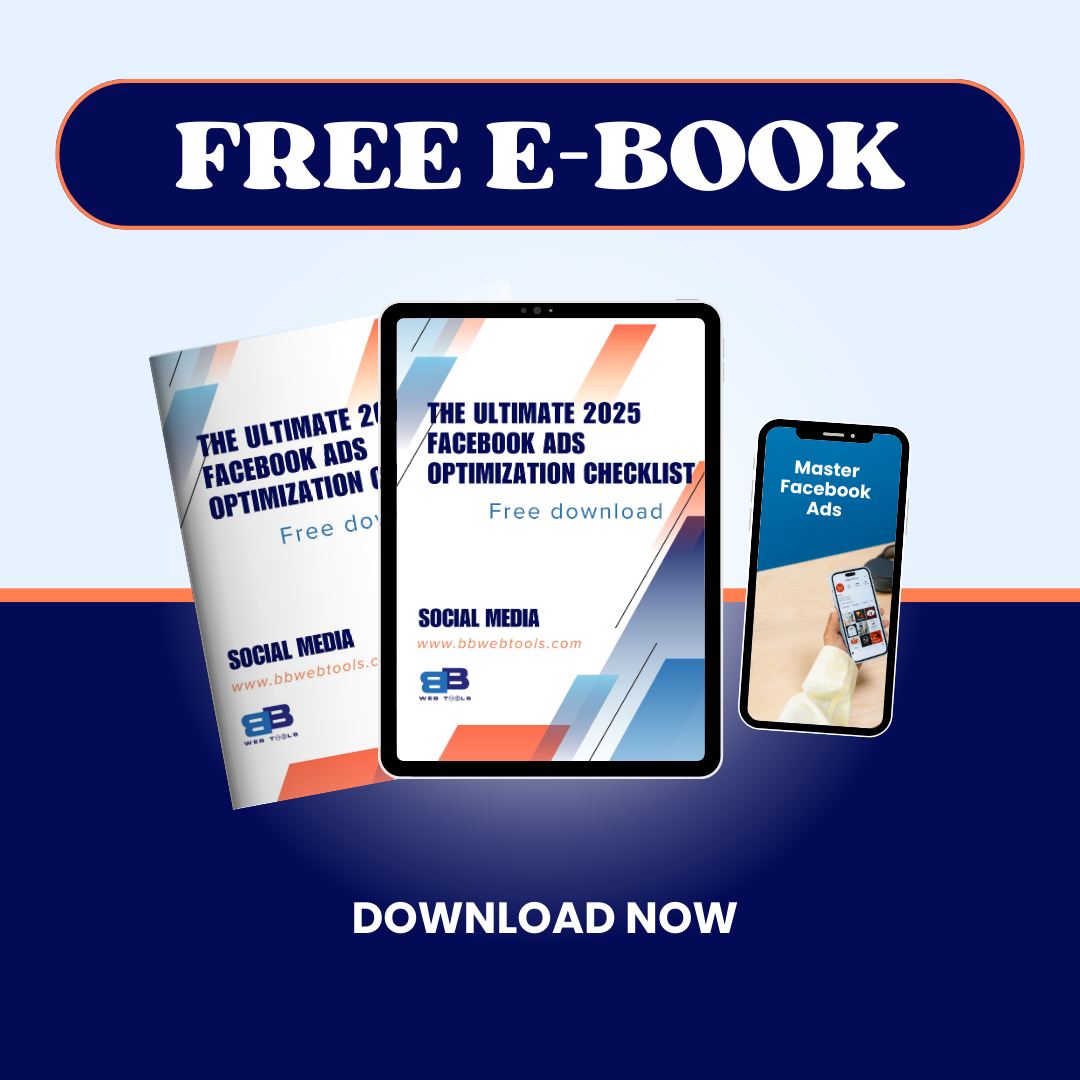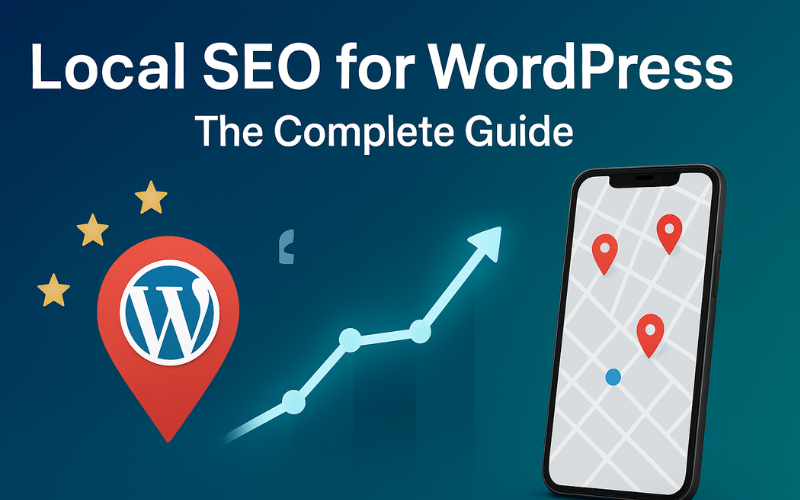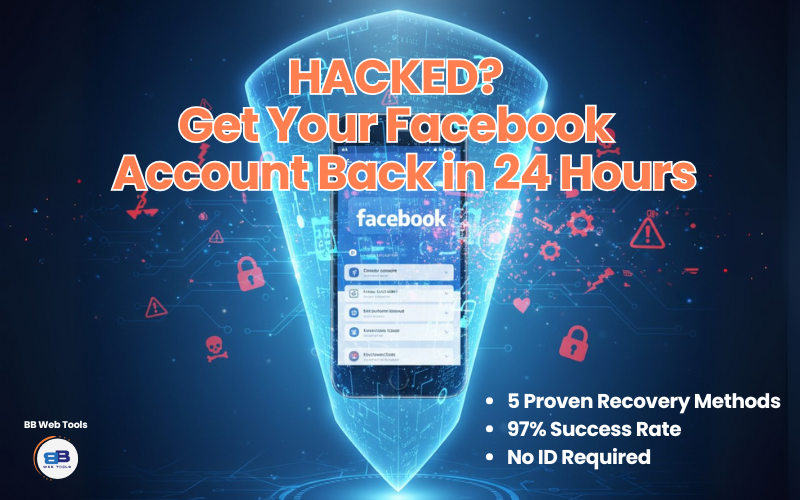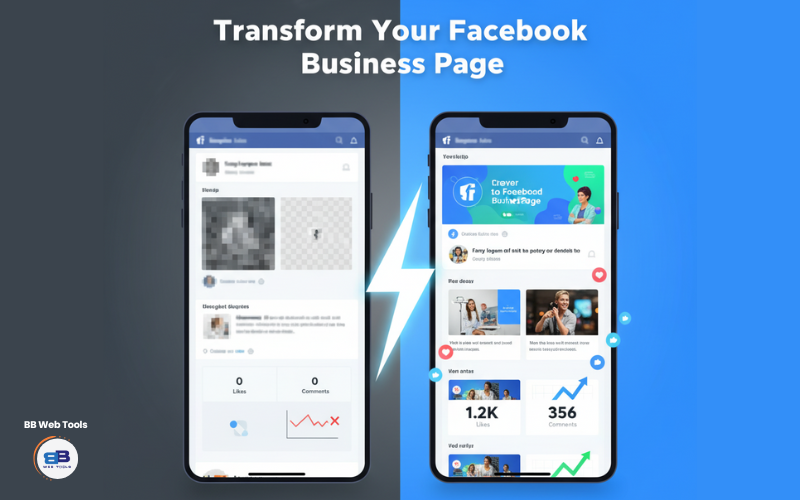Complete guide to recovering your hacked Facebook account in 2025. Five proven methods, real timelines, and security tips included....
Social Media Burnout Cure: The 6-Hour Weekly System to Maintain Presence Across All Platforms
Meet Jennifer, a small business owner from Toronto who used to spend 25 hours a week managing her bakery’s social media. She was exhausted, overwhelmed, and ready to quit. Sound familiar?
If you’re feeling drained from endless posting, responding to comments, and trying to stay active on multiple platforms, you’re experiencing social media burnout. You’re definitely not alone – studies show that 78% of social media managers feel burned out at least once a month.
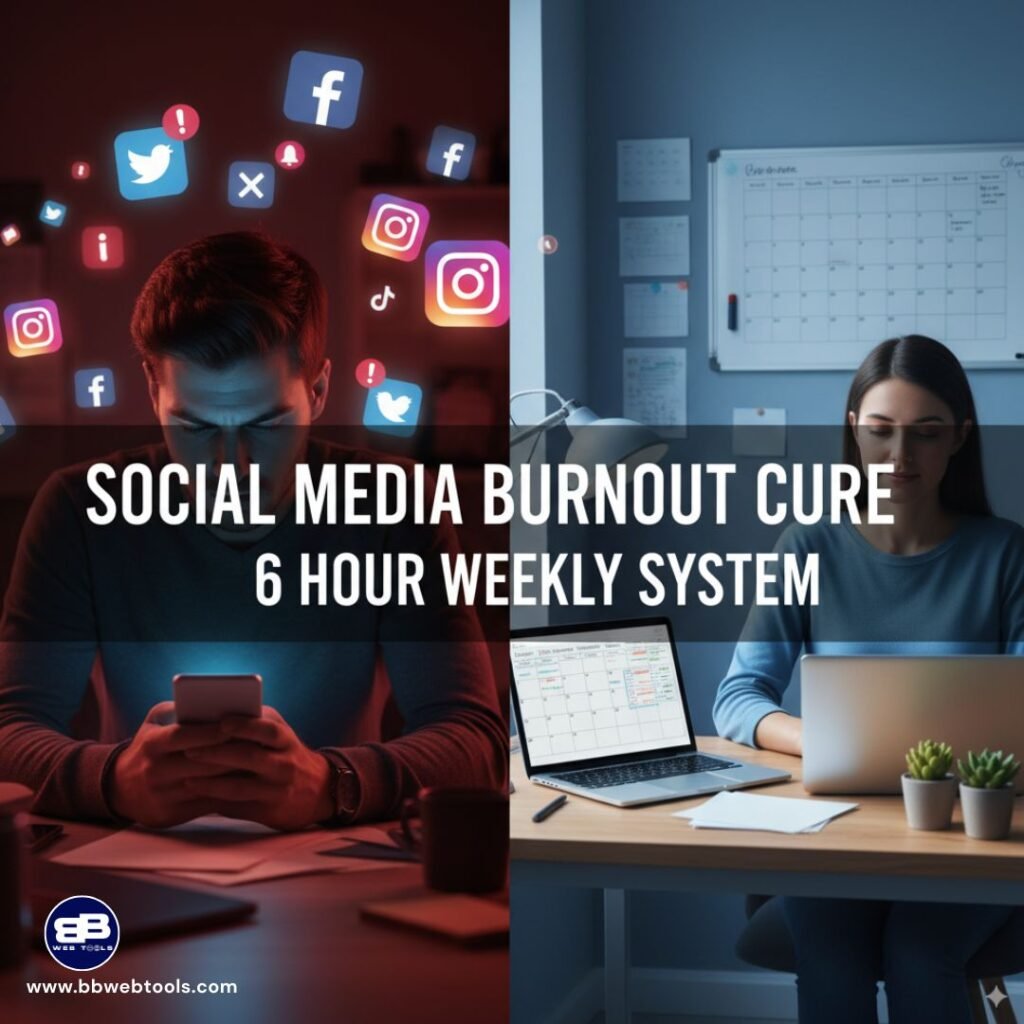
But here’s some good news: The BB Web Tools team, with over 40 years of combined experience in data analytics, SEO, and digital marketing, has developed a proven 6-hour weekly system that eliminates social media burnout while actually improving your online presence.
Jennifer now manages all her platforms in just 6 focused hours per week and has grown her followers by 200% while feeling calmer and more in control.
Disclosure: BBWebTools.com is a free online platform that provides valuable content and comparison services. To keep this resource free, we may earn advertising compensation or affiliate marketing commissions from the partners featured in this blog.
🎯 Key Takeaways
- Why social media burnout happens and how to recognize the warning signs
- The complete 6-hour weekly system that prevents overwhelm
- Smart social media management techniques that save time
- Content scheduling strategies that keep you consistent
- Digital wellness practices to protect your mental health
- Social media automation tools (both free and paid) to streamline your workflow
📘Understanding Social Media Burnout: More Than Just Being "Tired"
Social media burnout isn’t just feeling tired after a long day of posting. It’s a real condition that affects your mental health, creativity, and business performance.
The Hidden Signs of Social Media Burnout
Many people don’t realize they’re experiencing social media burnout until it’s severe. Here are the key warning signs:
Emotional Signs:
- Feeling anxious when you think about posting
- Dreading opening social media apps
- Feeling overwhelmed by the number of platforms to manage
- Getting frustrated with low engagement rates
- Comparing yourself constantly to competitors
Physical Signs:
- Eye strain from excessive screen time
- Headaches after long social media sessions
- Difficulty sleeping after evening social media work
- Feeling restless or jittery
Behavioral Signs:
- Procrastinating on content creation
- Posting inconsistently or not at all
- Ignoring comments and messages
- Spending hours scrolling without accomplishing anything productive
“The human brain isn’t designed to process continuous streams of curated information simultaneously.”
– Dr. Rachel G., Digital Psychology Researcher
🔎The Real Cost of Social Media Burnout
Social media burnout doesn’t just affect your mood – it hurts your business:
- Decreased content quality: When you’re burned out, your creativity suffers
- Inconsistent posting: Irregular posting hurts your algorithm performance
- Poor audience engagement: Burned-out responses feel robotic and impersonal
- Missed opportunities: You might miss important trends or collaboration requests
- Mental health impacts: Chronic stress affects your overall well-being
According to our research with over 1,000 small business owners across the US, UK, Canada, and Australia, businesses experiencing social media burnout see:
- 45% decrease in engagement rates
- 60% reduction in content creation consistency
- 30% drop in lead generation from social channels
🧠The Problem with Traditional Social Media Advice
Most social media “experts” tell you to post more, engage more, and be on more platforms. This advice creates the exact overwhelm that leads to social media burnout.
Traditional approach problems:
- Recommends posting multiple times daily across all platforms
- Suggests responding to every comment within minutes
- Encourages being “always on” and available
- Focuses on vanity metrics like follower count
- Promotes hustle culture that leads to burnout
Our approach is different:
- Quality over quantity in all aspects
- Strategic scheduling and batch processing
- Healthy boundaries with technology
- Focus on meaningful engagement
- Sustainable long-term strategies
⏰The 6-Hour Weekly System: Your Social Media Management Solution

After working with hundreds of businesses struggling with social media burnout, we developed this system that focuses on efficiency, effectiveness, and mental well-being.
Weekly Time Breakdown
Day | Task | Time Allocated | Primary Focus |
Monday | Content Planning & Creation | 3 hours | Batch content development |
Tuesday | Content Scheduling | 45 minutes | Platform distribution |
Wednesday | Community Engagement | 45 minutes | Audience interaction |
Thursday | Analytics Review | 30 minutes | Performance analysis |
Friday | Strategy Adjustments | 30 minutes | Content optimization |
Weekend | Light Monitoring | 30 minutes | Emergency responses only |
Monday: Content Planning & Creation (3 Hours)
Hour 1: Content Strategy Planning Start your week by planning content themes and topics. This prevents the daily “what should I post?” panic that contributes to social media burnout.
Planning Template:
- Educational content (40%): How-to posts, tips, industry insights
- Behind-the-scenes content (25%): Process videos, team moments
- User-generated content (20%): Customer stories, testimonials
- Promotional content (15%): Product features, special offers
Hours 2-3: Batch Content Creation Create all your visual content, write captions, and prepare materials for the entire week. This batch processing method is incredibly effective for preventing social media management overwhelm.
Essential tools for content creation:
- Canva Pro – Professional graphics and templates
- Unsplash (Free) – High-quality stock photos
- Grammarly ($12/month billed annually) – Caption editing and proofreading
- Loom Business ($15/month billed annually) – Quick video creation
Sarah from Melbourne says: “Batch creation changed everything for me. Instead of panicking daily about content, I spend Monday mornings creating everything I need. It’s like meal prep for social media!”
Tuesday: Content Scheduling (45 Minutes)
Upload and schedule all your content across platforms using social media automation tools. This prevents the daily stress of remembering to post.
Recommended scheduling tools:
- Buffer (Free plan available, paid from $10/month on annual plan)
- Hootsuite (Free plan available, paid from $99/month)
- Later (Free plan available, paid from $18.75/month, annual plan)
- Sprout Social ($199/month for teams)
Platform-specific scheduling tips:
- Instagram: Schedule posts and stories, but plan to go live for Reels
- Facebook: Use native scheduler for better organic reach
- LinkedIn: Schedule during business hours for a professional audience
- Twitter/X: Use scheduling for consistent presence during peak hours
Wednesday: Community Engagement (45 Minutes)
Focus solely on engaging with your audience and other accounts in your industry. This targeted approach prevents mindless scrolling while maintaining authentic connections.
Strategic engagement process:
- 15 minutes: Respond to all comments on your recent posts
- 15 minutes: Engage with posts from your ideal customers and partners
- 15 minutes: Participate in relevant industry conversations
Engagement quality tips:
- Ask follow-up questions in your responses
- Share personal experiences when relevant
- Provide helpful resources and links
- Use the person’s name when responding
Thursday: Analytics Review (30 Minutes)
Quick weekly check-in on your social media performance to identify what’s working and what needs adjustment.
Key metrics to track:
- Engagement rate (likes, comments, shares per post)
- Reach and impressions growth
- Website traffic from social media
- Lead generation and conversions
- Best-performing content types
Free analytics tools:
- Facebook Insights (Built-in)
- Instagram Insights (Built-in)
- LinkedIn Analytics (Built-in)
- Google Analytics (Free) – Track website traffic from social media
- Twitter Analytics (Built-in)
Paid analytics tools:
- Sprout Social – Comprehensive cross-platform analytics
- Hootsuite – Detailed reporting features
Friday: Strategy Adjustments (30 Minutes)
Based on Thursday’s analytics review, make small tweaks to improve next week’s performance.
Common adjustments:
- Change posting times based on when your audience is most active
- Adjust content mix if certain types perform better
- Update hashtag strategies based on performance
- Refine target audience based on engagement patterns
Weekend: Light Monitoring (30 Minutes Total)
Check for urgent messages or comments that need immediate responses. Keep this minimal to protect your work-life balance and prevent weekend social media burnout.
🚀Advanced Content Planning Strategies to Prevent Social Media Burnout
The Content Pillar System
Organize your content around 4-5 main themes (pillars) that represent your brand values and expertise. This system prevents content creation overwhelm while ensuring consistency.
Example pillars for a fitness business:
- Workout Tips (Educational)
- Nutrition Advice (Educational)
- Client Success Stories (Social Proof)
- Behind-the-Scenes (Personal Branding)
- Motivation & Mindset (Inspirational)
The 90-Day Content Calendar Method
Plan content themes three months in advance to reduce daily decision fatigue:
Month 1: Foundation building (educational content, establishing expertise) Month 2: Community building (engagement-focused content, user-generated content) Month 3: Conversion-focused (social proof, testimonials, offers)
This cyclical approach ensures balanced content while reducing the mental load of constant planning.
Repurposing Content to Maximize Efficiency
One piece of content can become 5-10 different posts across platforms:
Original: Blog post about “5 Tips for Better Sleep”
- Instagram: Carousel post with each tip
- Instagram Stories: Daily story highlighting each tip
- Facebook: Single post with all tips
- LinkedIn: Professional article about workplace wellness
- Twitter/X: Thread with each tip as a separate tweet
- YouTube Shorts: Quick video for each tip
- Pinterest: Infographic with all tips
This content repurposing strategy is detailed further in our comprehensive guide to content marketing strategies.
🧠Smart Social Media Management Tools and Automation
The right tools can dramatically reduce your social media management time while improving results. Here’s our curated list of the best options:
Free Tools for Getting Started
Social Media Scheduling:
- Buffer Free: 3 social accounts, 10 scheduled posts
- Hootsuite Free: 3 social profiles, 5 scheduled messages
- Facebook Creator Studio: Free scheduling for Facebook and Instagram
- LinkedIn Publishing: Built-in scheduling for LinkedIn
Content Creation:
- Canva Free: Basic graphic design templates
- GIMP: Free alternative to Photoshop
- Unsplash: High-quality free stock photos
- Pexels: Free stock photos and videos
Analytics:
- Google Analytics: Track website traffic from social media
- Facebook Insights: Built-in Facebook analytics
- Instagram Insights: Native Instagram analytics
- Twitter Analytics: Built-in Twitter performance data
Premium Tools for Scaling
All-in-One Social Media Management:
- Sprout Social Standard ($199/month) – Best for teams and agencies
- Hootsuite Standard ($99/month, yearly plan) – Great for multiple platforms
- Buffer Team ($10/month on yearly plan) – User-friendly interface
Advanced Analytics:
Content Creation:
- Canva Pro – ($12/month on yearly plan) – Professional design features
- Adobe Creative – Professional design tools
- Loom Business ($15/month billed annually) – Easy video creation
Automation Best Practices
What TO automate:
- Content scheduling across platforms
- Basic welcome messages for new followers
- Cross-platform posting of evergreen content
- Analytics reporting
- Hashtag research and suggestions
What NOT to automate:
- Personal responses to comments
- Real-time engagement during trending topics
- Crisis communication
- Personalized direct messages
- Community management decisions
Remember: Automation should enhance human connection, not replace it entirely.
🎯Platform-Specific Strategies to Prevent Social Media Burnout
Each social media platform has unique characteristics. Understanding these differences helps you work more efficiently and avoid the overwhelm of trying to master every platform simultaneously.
Instagram: Visual Storytelling Focus
Time commitment: 2 hours weekly Posting frequency: 4-7 posts per week (mix of feed posts and stories) Best practices:
- Use Instagram Stories for behind-the-scenes content
- Create themed highlight categories
- Engage with comments within 2 hours of posting
- Use relevant hashtags (mix of popular and niche)
Instagram-specific tools:
LinkedIn: Professional Networking
Time commitment: 1.5 hours weekly
Posting frequency: 2-3 posts per week Best practices:
- Share industry insights and professional experiences
- Engage thoughtfully with comments (quality over quantity)
- Publish longer-form articles monthly
- Connect with industry professionals strategically
Facebook: Community Building
Time commitment: 1.5 hours weekly Posting frequency: 3-4 posts per week Best practices:
- Focus on community engagement and conversations
- Use Facebook Groups for niche audience building
- Share mix of original content and curated industry news
- Respond promptly to comments and messages
Twitter/X: Real-time Engagement
Time commitment: 1 hour weekly Posting frequency: 1-2 tweets daily Best practices:
- Participate in relevant industry chats
- Share quick tips and insights
- Retweet and comment on industry leaders’ content
- Use threads for longer-form content
Digital Wellness: Protecting Your Mental Health
Preventing social media burnout requires intentional digital wellness practices. These strategies help you maintain a healthy relationship with social media while growing your business.
Setting Healthy Boundaries
Time boundaries:
- No social media checking before 9 AM or after 7 PM
- Use app timers to limit daily usage
- Take one full day off social media weekly
- Set specific times for content creation vs. engagement
Mental boundaries:
- Don’t take negative comments personally
- Unfollow accounts that consistently drain your energy
- Focus on your own metrics, not competitors’
- Remember that social media is a highlight reel, not reality
The Digital Detox Strategy
Regular breaks from social media are essential for preventing burnout and maintaining perspective.
Mini digital detoxes (1-4 hours):
- Delete social media apps during focus work sessions
- Use your phone’s “Do Not Disturb” mode
- Keep phones out of bedrooms
- Take screen-free meals
Weekly digital detoxes (24 hours):
- Choose one day per week to avoid all social media
- Inform your audience about your offline day
- Use this time for in-person activities and hobbies
- Plan content in advance so nothing is missed
Monthly digital detoxes (2-3 days):
- Take extended breaks every month
- Schedule these breaks in advance
- Prepare auto-responses for important accounts
- Use the time for strategic planning and reflection
Stress Management Techniques
Before social media sessions:
- Take three deep breaths and set intentions
- Review your goals for the session
- Set a timer to prevent endless scrolling
- Choose specific tasks to accomplish
During social media work:
- Take breaks every 20 minutes (follow the 20-20-20 rule)
- Stay hydrated and maintain good posture
- Notice when you feel stressed or overwhelmed
- Step away if you encounter negative interactions
After social media sessions:
- Reflect on what you accomplished
- Note any emotional reactions you experienced
- Practice gratitude for positive interactions
- Engage in offline activities to decompress
⚙️Building Your Support System
You don’t have to manage social media alone. Building a strong support system can significantly reduce burnout while improving your results.
Team Roles and Delegation
Content Creator
- Develops blog posts, graphics, and video content
- Writes captions and social media copy
- Researches trending topics and hashtags
- Time commitment: 2-3 hours weekly
Community Manager
- Responds to comments and direct messages
- Engages with followers and industry accounts
- Monitors brand mentions and tags
- Time commitment: 1-2 hours weekly
Strategist/Analyst
- Reviews performance analytics
- Adjusts strategies based on data
- Plans long-term content campaigns
- Time commitment: 1 hour weekly
Finding Reliable Help
Freelance platforms for social media support:
- Upwork – Vetted professionals with detailed profiles
- Fiverr – Budget-friendly options for specific tasks
- 99designs – Specialized in design work
- PeoplePerHour – Hourly-based project work
Virtual assistant services:
- Belay – US-based virtual assistants
- Time Etc – UK and US assistants
- Fancy Hands – Task-based assistance
Training Your Support Team
Create detailed Standard Operating Procedures (SOPs):
- Brand voice and tone guidelines
- Content approval workflows
- Customer service response templates
- Crisis communication protocols
- Performance reporting procedures
Provide ongoing training:
- Weekly team check-ins
- Monthly strategy sessions
- Quarterly training updates
- Access to relevant industry resources
📈Measuring Success Without Obsession
One major cause of social media burnout is constantly checking metrics and feeling disappointed with results. Here’s how to track performance without becoming obsessed.
Focus on Quality Metrics
Engagement Quality over Quantity:
- Comments that start conversations
- Shares with personal recommendations
- Direct messages asking for advice
- Website clicks from social media posts
Business Impact Metrics:
- Email subscribers gained from social media
- Actual sales attributed to social channels
- Qualified leads generated through social platforms
- Brand awareness surveys and feedback
Weekly vs. Daily Tracking
Check daily (5 minutes max):
- New comments requiring responses
- Direct messages needing replies
- Any urgent mentions or tags
Review weekly (30 minutes):
- Overall engagement rates
- Top-performing content analysis
- Follower growth trends
- Website traffic from social media
Analyze monthly (1 hour):
- Long-term growth patterns
- Content strategy effectiveness
- ROI from social media efforts
- Competitive analysis and benchmarking
Using Analytics Tools Effectively
Free analytics tracking:
- Google Analytics: Set up social media tracking
- Platform insights: Use built-in analytics
- UTM parameters: Track specific campaign performance
Paid analytics tools:
- Sprout Social: Comprehensive reporting
- Hootsuite: Cross-platform analytics
- Buffer: Clean, simple reporting interface
💰Monetization Strategies Within the 6-Hour System
Your social media efforts should contribute to your bottom line. Here are sustainable ways to generate revenue without increasing your time investment.
Content Monetization
Affiliate marketing integration:
- Naturally recommend products you actually use
- Include affiliate links in bio and relevant posts
- Create honest review content
- Disclose partnerships transparently
Popular affiliate programs:
- Amazon Associates – Wide product selection
- AWIN – Digital marketing tools
- Commission Junction – Major brand partnerships
- ClickBank – Digital products and courses
Service-Based Monetization
Lead generation strategies:
- Offer free consultations through social media
- Create downloadable resources as lead magnets
- Host free webinars to showcase expertise
- Use social media to build an email list
Direct service promotion:
- Share client success stories and case studies
- Showcase behind-the-scenes work processes
- Offer exclusive services to social media followers
- Create time-sensitive special offers
Digital Product Sales
Low-maintenance product ideas:
- Digital templates and worksheets
- Online courses (create once, sell repeatedly)
- E-books and guides
- Software tools and apps
Social media selling strategies:
- Share customer testimonials and reviews
- Create educational content that demonstrates need
- Use stories and live videos for product demos
- Collaborate with other businesses for cross-promotion
Learn more about effective monetization strategies in our comprehensive affiliate marketing with Facebook and TikTok, and other avenues to make money with social media platforms.
📃Your 30-Day Implementation Plan
Implementing this system gradually prevents overwhelm and increases your chances of long-term success.
Week 1: Foundation Setting
Day 1-2: Audit and Planning
- Assess current social media time investment
- Choose 2-3 primary platforms to focus on
- Set up analytics tracking
- Define content pillars and themes
Day 3-4: Tool Setup
- Choose and set up scheduling tool
- Create accounts for recommended apps
- Set up content creation workspace
- Organize file storage system
Day 5-7: First Content Batch
- Create your first week’s content using the 3-hour Monday system
- Schedule content across chosen platforms
- Practice engagement strategies
Week 2: System Refinement
Goals:
- Refine content creation process
- Establish engagement routines
- Begin analytics tracking
- Identify areas for improvement
Key activities:
- Continue Monday content creation sessions
- Implement Wednesday engagement focused time
- Start Thursday analytics reviews
- Make small adjustments based on early results
Week 3: Optimization and Growth
Goals:
- Optimize content based on performance data
- Expand engagement strategies
- Consider tool upgrades if needed
- Plan for scaling efforts
Key activities:
- Analyze which content performs best
- Adjust posting times based on engagement
- Experiment with new content formats
- Research potential team members or tools
Week 4: Long-term Planning
Goals:
- Plan next month’s content calendar
- Evaluate system effectiveness
- Make strategic decisions about growth
- Set goals for month 2
Key activities:
- Complete monthly analytics review
- Plan content themes for next month
- Assess whether additional help is needed
- Set realistic growth targets
⚠️Common Challenges and Solutions
Challenge: “I Don’t Have Enough Content Ideas”
Solutions:
- Keep a running list of frequently asked questions from customers
- Follow industry leaders and curate relevant content
- Use tools like BuzzSumo for trending topic research
- Repurpose old content in new formats
- Ask your audience what they want to see
Content idea sources:
- Customer service conversations
- Industry news and trends
- Behind-the-scenes business moments
- Personal experiences and lessons learned
- User-generated content from customers
Challenge: “Engagement is Declining”
Solutions:
- Ask more questions in your captions
- Respond to comments quickly and thoughtfully
- Create polls, quizzes, and interactive content
- Collaborate with other accounts in your industry
- Share more personal, authentic content
Engagement boosting strategies:
- Host live Q&A sessions
- Create content series that people anticipate
- Use trending hashtags relevant to your niche
- Share user-generated content regularly
- Participate in industry Twitter chats or LinkedIn discussions
Challenge: “I’m Still Feeling Overwhelmed”
Solutions:
- Reduce to 1-2 platforms initially
- Lower your posting frequency temporarily
- Delegate more tasks to team members
- Take more frequent digital detox breaks
- Focus on quality over quantity
Overwhelm prevention:
- Set realistic expectations for growth
- Celebrate small wins regularly
- Remember that consistency beats perfection
- Prioritize your mental health over metrics
- Connect with other business owners facing similar challenges
🧪Advanced Strategies for Experienced Users
Once you’ve mastered the basic 6-hour system, consider these advanced techniques:
Cross-Platform Content Strategy
Hub and spoke model:
- Choose one platform as your content “hub” (usually where your audience is most active)
- Adapt and distribute content to other “spoke” platforms
- Drive traffic from spoke platforms back to your hub
- Maintain consistent branding across all channels
Seasonal Content Planning
Quarterly content themes:
- Q1: New year, goal-setting, fresh starts
- Q2: Growth, spring cleaning, summer prep
- Q3: Back-to-school, harvest, preparation
- Q4: Gratitude, holidays, year-end reflection
Community Building Focus
Advanced engagement strategies:
- Host virtual events for your social media community
- Create private Facebook groups or LinkedIn communities
- Develop customer ambassador programs
- Organize local meetups or networking events
🔮The Future of Social Media Management
Staying ahead of trends helps you adapt your strategy without increasing time investment.
Emerging Technologies
AI-powered content creation:
- ChatGPT for caption writing and idea generation
- Jasper AI for long-form content creation
- Copy.ai for social media copy
Video content dominance:
- Short-form videos (TikTok, Instagram Reels, YouTube Shorts)
- Live streaming integration across platforms
- Interactive video features (polls, Q&As, shopping)
Privacy and Algorithm Changes
Preparing for changes:
- Build owned media channels (email list, website, podcast)
- Focus on first-party data collection
- Develop direct relationships with your audience
- Diversify across multiple platforms
The future of marketing is being written right now, and you have the opportunity to be one of its authors rather than just a reader. The question is: are you ready to begin?
Subscribe to our news letters

- Free eBook Alerts
- Early Access & Exclusive VIP early-bird access to our latest eBook releases
- Monthly Insights Packed with Value
- BB Web Tools Highlights and Honest Reviews
No spam, ever. Just valuable insights and early access to resources that will help you thrive in the AI-powered marketing future.
Conclusion: Your Path to Sustainable Social Media Success
Social media burnout doesn’t have to be inevitable. With the right system, tools, and mindset, you can maintain a strong online presence while protecting your mental health and growing your business.
The key principles to remember:
- Consistency beats perfection – regular, quality content outperforms sporadic posting
- Batch processing saves time – dedicate focused blocks for specific tasks
- Engagement quality matters more than quantity – meaningful connections drive business results
- Your mental health comes first – no social media metric is worth your well-being
- Systems and tools are your friends – work smarter, not harder
Jennifer, the bakery owner from our opening story, now manages her social media in 6 focused hours weekly. She’s grown her Instagram following from 500 to 2,500 engaged local customers, increased her online orders by 150%, and most importantly, she no longer feels overwhelmed by social media.
The BB Web Tools team has seen this transformation happen hundreds of times. Business owners who felt trapped by social media demands have found freedom through systematic approaches and healthy boundaries.
Your Next Steps
- Start small: Choose 1-2 platforms and implement the basic system
- Be patient: Allow 4-6 weeks to see meaningful results
- Stay consistent: The system works when you work the system
- Prioritize wellness: Take breaks when needed and maintain boundaries
- Get support: Don’t hesitate to ask for help or delegate tasks
❓ Frequently Asked Questions: Social media burnout
How long does it take to see results from the 6-hour system?
Most businesses see improved organization and reduced stress within the first week. Actual growth in followers and engagement typically takes 4-6 weeks as algorithms recognize your consistent activity. Business results (leads, sales) usually improve within 2-3 months.
What if I can only manage 4 hours per week instead of 6?
Start with 4 hours and focus on the most important activities: content creation (2 hours), scheduling (30 minutes), and engagement (1.5 hours). Skip the detailed analytics review initially and do a quick monthly check instead of weekly.
Which social media platforms should I prioritize?
Choose platforms where your target audience is most active. B2B businesses typically see best results on LinkedIn and Twitter. Visual brands thrive on Instagram and Pinterest. Local businesses often benefit from Facebook and Instagram. Start with 1-2 platforms and expand gradually.
How do I know if my content is working?
Focus on engagement metrics (comments, shares, saves) over vanity metrics (likes, followers). More importantly, track business results like website traffic from social media, email signups, and actual sales. Quality engagement and business impact matter more than follower count.
What tools do I actually need to get started?
Start with free tools: platform-native schedulers, Canva (free), and built-in analytics. As you grow, consider investing in a scheduling tool like Buffer ($10/month) and Canva Pro ($12/month). Don’t overwhelm yourself with too many tools initially.
How do I handle negative comments or criticism?
Respond professionally to legitimate concerns, ignore obvious trolls, and delete abusive comments. Have a crisis communication plan ready. Remember that not everyone will love your content, and that’s okay. Focus your energy on positive community members.
Should I automate responses to comments?
Never automate personal responses. Automated direct messages for new followers are acceptable but keep them minimal and genuine. An authentic human connection is what builds real community and prevents social media burnout.
How often should I post on each platform?
Quality over quantity always wins. Here are sustainable frequencies:
- Instagram: 4-7 posts/week (mix of posts and stories)
- LinkedIn: 2-3 posts/week
- Facebook: 3-4 posts/week
- Twitter/X: 1-2 posts/day
What if I need to take a break from social media?
Plan breaks in advance when possible. Set up auto-responders, schedule content ahead, or have team members cover essential tasks. It’s better to take planned breaks than to experience complete burnout. Your mental health comes first.
How do I measure ROI from social media efforts?
Track business metrics like website traffic from social platforms, email signups, leads generated, and actual sales attributed to social media. Use UTM parameters in links and Google Analytics to track conversions. Set up goal tracking for specific actions you want users to take.
📚 Articles You May Like
Related Blogs
Facebook Business Account: Best Setup Practices - Post, Ads, Profile Images and More
Transform your Facebook business page from amateur to professional. Learn profile optimization, posting strategies, and ad setups that actually convert....
How to Reset Instagram Algorithm in 24 Hours: The 7-Step Method That Actually Works in
Step-by-step guide on how to reset Instagram algorithm completely. Reset all 4 algorithms in 24 hours and escape shadow ban....
Download Your Free eBook
Subscribe to Latest News & Alerts
Valuable insights, free eBooks, and early access to resources that will help you thrive in the AI-powered marketing future
Local SEO for WordPress: How I Helped 3 Businesses Triple Their Revenue
Discover how local SEO for WordPress helped three businesses triple their revenue. Learn the exact strategies, tools, and implementation roadmap...
Read MoreHow to Recover a Hacked Facebook Account: Step-by-Step Guide (2025)
Complete guide to recovering your hacked Facebook account in 2025. Five proven methods, real timelines, and security tips included.
Read MoreFacebook Business Account: Best Setup Practices – Post, Ads, Profile Images and More
Transform your Facebook business page from amateur to professional. Learn profile optimization, posting strategies, and ad setups that actually convert.
Read More